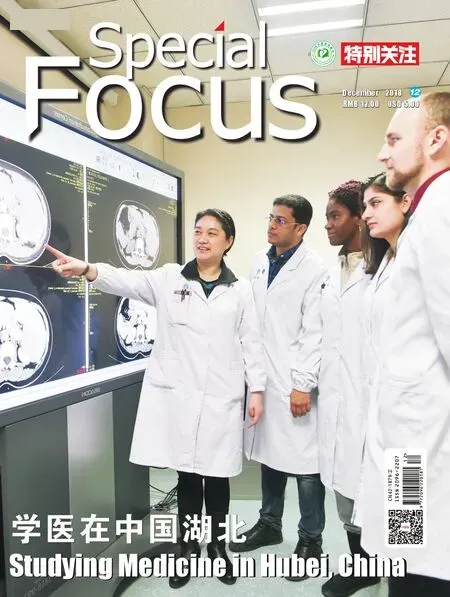Winter Solstice
By Zhang Chengyi
The 22nd of December marks the Winter Solstice for the year of 2018. As one of the 24 solar terms, Winter Solstice is quite unique.
Approximately three thousand years ago, Sage Zhou,one of the greatest politicians,educators, and thinkers in Chinese history, measured the “center of the world” with a stone plate and a needle.After that, through extended observation of the movement of the sun, sagacious Chinese ancestors came up with a system of determining the seasonal alternation by dividing the entire solar period by a factor of 24, which still serves as an important guide for continental monsoon climate agriculture.
As the twenty-second solar term, Winter Solstice is when the daytime is at its shortest and nighttime at its longest. In other words, Winter Solstice occurs when the earth travels around the near-sun point and the sun shines straight on the tropic of Capricorn. Due to the fact that Earth's orbit around the sun is actually 365 days 5 hours and 48 minutes, the date for the Winter Solstice varies from the twentyfirst to the twenty-third of December, and it is also known as “the day of revival.” After the Winter Solstice, the relative position of the sun travels northward, and daytime in the northern hemisphere increases.“YIN,” the air of darkness starts to decline, while “YANG,” the air of brightness begins to bounce.Because the YANG arises, the Winter Solstice in Chinese is named as the “initial warmth rise.” Consequently, Winter Solstice is when the livelihood of nature is awakened—and a new cycle of the year begins. In this sense, Winter Solstice is known as the “vice new year,”indicating its significant roleamong all 24 solar terms.
Phenology is the study of the periodic change of living organism's response to seasonal changes. The Winter Solstice constitutes one of three major phenological phenomenon—traditionally, it causes the earthworms agglomerate, five days later the elks slough their antlers, and ten days later the springs and brooks start to flow.
On the day of Winter Solstice,YIN reaches its maximum,as we've mentioned before.Earthworms, as our ancestors said to be, are animals that curl in darkness and extend outward in brightness. As a result, at the Winter Solstice, earthworms remain agglomerated in the soil.Five days after Winter Solstice,the rise in YANG becomes noticeable. Elks, with their antlers pointing backward, are considered to be animals that prefer darkness to brightness.Consequently, five days after the Winter Solstice, elks slough their antlers in response to the declining YIN. Ten days after Winter Solstice, the rise in YANG becomes more influential.Springs, which were frozen in previous seasons, start to melt now. The streams murmur and the water it holds is comfortably warm instead of freezing cold,and other living things can then begin to sprout and grow.
As the saying goes, “Winter Solstice is as important as New Year.” Indeed, Winter Solstice was one of the most important solar terms among all 24. The tradition of praying on Winter Solstice has been established since the Zhou Dynasty (1046 BC-256 BC). Praying at Winter Solstice is believed to be effective in reducing famine, epidemics,and the overall death rate. In the Han Dynasty (202 BC-220),Winter Solstice is celebrated with a day off and a national-scale concert for celebrating the new cycle. In the Tang Dynasty (618 -907), people bought new clothes,threw feasts, and honored their ancestors at the Winter Solstice.
Nowadays, Winter Solstice is celebrated less grandly, for Chinese traditions are diluted with all those fascinating western celebrations. Still, traditional cuisine keeps on reminding us of this once-in-a-year celebration.In Gusu, Suzhou, local people brew “winter-brewed wine,”a rice-based wine with the fragrance of osmanthus flower—they sip the wine gently at the night of Winter Solstice. In Northern China, it is a longheld tradition to eat dumplings at the Winter Solstice, because two thousand years ago, Zhang Zhongjing, the saint of medicine,used these ear-shaped, warm,delicious morsels to cure the frozen ear symptoms of residents on the Winter Solstice Day. In Southern China, people eat red bean sticky rice stew to prevent frightening phantoms from haunting them.
The 22nd of December might be an ordinary Saturday for some, since many Chinese now no longer lead an agriculturebased life, and the solar terms are less indispensable to our lives. However, as the inheritors of a culture with thousands of years of history, it's still quite pleasant and enjoyable for us to have a bowl of hot dumplings or some red bean sticky rice together with the family on the day of Winter Solstice,just as what Westerners do on Christmas Eve.

冬 至
文/张成熠
2018年12月22日是中国二十四节气之一的冬至日。
约莫三千年前,政治家、教育家和思想家周公,用石盘与石针制成的土圭测量出了“天下之中”。自此以后,中国古代天文学者通过对太阳轨迹的长期观察,将太阳运行周期二十四等分,形成了可以衡量季节交替的节气系统,成为中国农耕的重要指引。
冬至是中国二十四节气中的第二十二个,是北半球昼极短夜极长之日。这一天,地球运行在近日点附近,太阳正好直射南回归线。由于地球围绕太阳运行一周(一个太阳年)的实际时间为365天5小时48分多钟,故冬至日的时间会有所变动,一般在12月21-23日之间,也称为“活节”。冬至日一过,太阳北回,北半球从此日照增加,阴气由极盛转衰;阳气由极衰开始复苏。阳气增长,此称“一阳升”。因此,冬至之时万物复苏,新年伊始,古人称之为“亚年”——这一称谓也从侧面反映了冬至在二十四节气中的重要性。
中国古人将冬至分为三候:“一候蚯蚓结,又五日麋角解,又五日水泉动。” 冬至之日,如前文所提,阴气盛至极点。蚯蚓,如老祖宗所说,是阴曲阳伸的生物。所以,此日蚯蚓仍虬结于土中。冬至五日之后,阳气渐生。麋、鹿同源,而麋因其角向后生长,被古人认为趋阴避阳。因此,冬至五日后,麋感到阴气渐退而解其角。冬至十日之后,阳气更盛。封冻的山泉开始流动。至此,山泉潺潺,而且温热,万物才可萌发生长。

俗语有云,冬至大如年。 各地皆有过冬至的习俗自周朝 (前1046—前256)起,人们在冬至日祭祀,以求消灾、减免瘟疫饥荒以及延缓死亡。在汉代(前202—公元220),人们会在冬至日休息一天,举国上下鼓瑟吹笙,以表庆祝。在唐朝(618—907),人们会在冬至日置办新衣,大摆宴席,祭祀先祖。
如今,冬至日的盛况不复从前,中国的传统习俗已被花哨的、吸引人的西方节日冲淡了不少。尽管如此,冬至的传统佳肴依然令人思念和向往。 在苏州,人们会酿“冬酿酒”,把桂花加在米酒中酿成香醇美酒。冬至日开坛,小酌几杯,酒香、桂香满屋。在中国北方,饺子是冬至日的传统食物。相传医圣张仲景在冬至那天用暖暖和和的“娇耳”(饺子)缓解了当地居民的冻耳朵症状;而后,娇耳演化为如今家喻户晓的饺子。在中国南方,人们会吃赤豆糯米饭来消灾避邪。
2018年12月22日,一个普通的星期六。作为继承着已传承了千年之久的文化精髓的一代人,在凛冬已至之时吃一碗热乎乎的饺子或红豆糯米饭,图一个亲人相聚的时刻,像西方过圣诞那样,也是一种惬意和享受。

